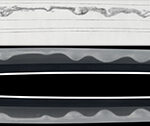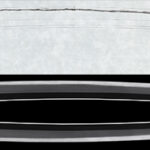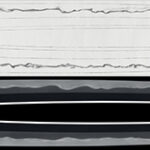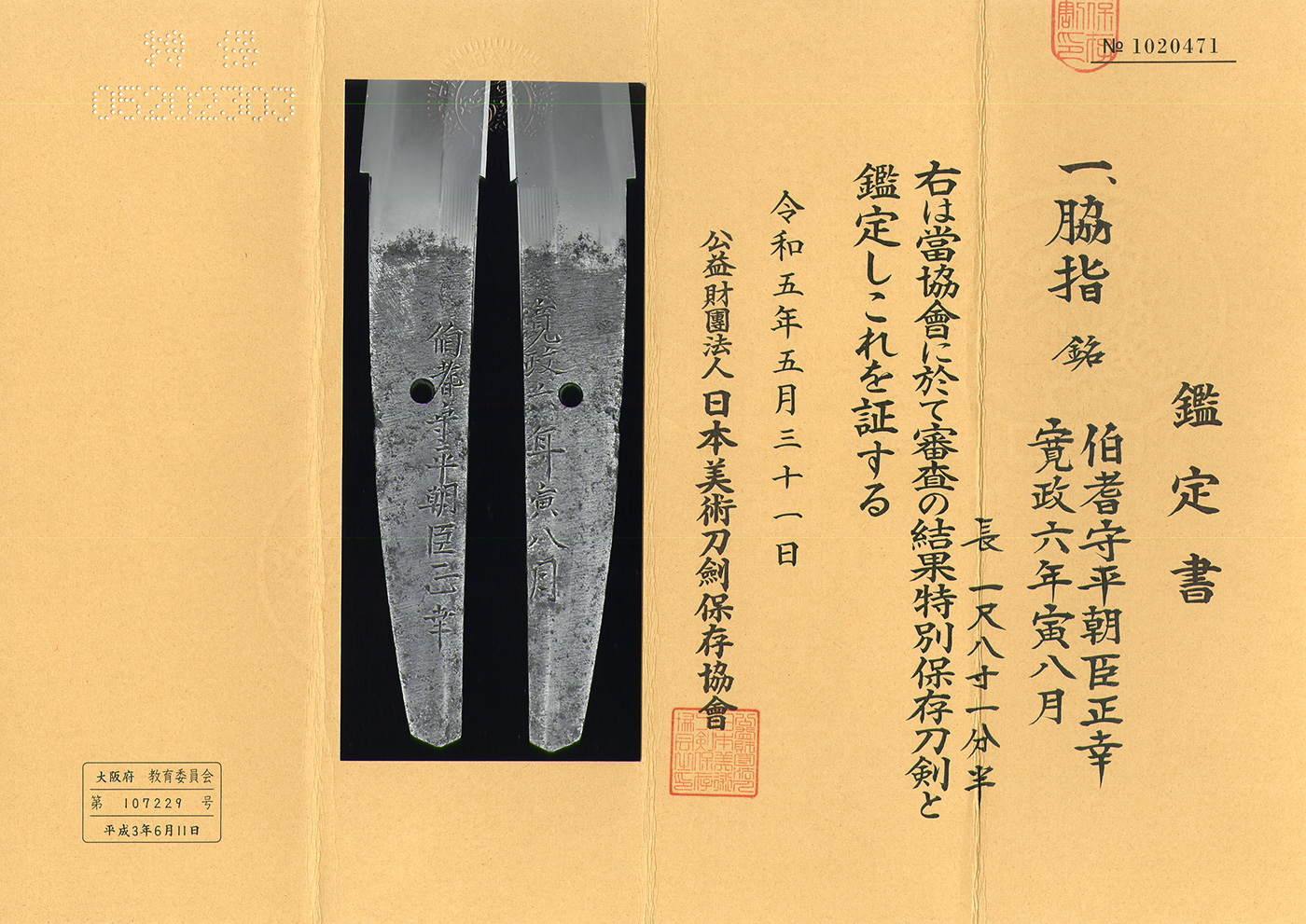Ordering number: 23378
Wakizashi In Shirasaya(NBTHK Tokubetsu Hozon Token)
Inscription (Mei): Hoki Kami Ason Masayuki
伯耆守朝臣正幸
Kansei 6 Nen 8 Gatsu Hi
寛政六年八月日
Shinshinto: Josaku: Satsuma
We categorize our swordsmiths' works as Juyo-saku (highest quality), Jojo-saku (excellent), Jo-saku (good), and Futsu-saku (average). This piece is ranked as Jojo-saku, indicating it is an excellent work.
Polished
Habaki: Silver single Habaki
Blade Length: 56.2 centimeters or 22.13 inches
Curvature: 1.4 centimeters or 0.55 inches
Mekugi-ana (peg hole): 1
Width at the Base: 3.37 centimeters or 1.33 inches
Thickness: 0.68 centimeters or 0.27 inches
Weight: 620 grams
Era: Kansei 6th Year (approx. 1794)
Shape: The blade has a wide width of 3.37 cm and a triangular shape with a moderate curvature, and the tip extends to create a graceful and formidable piece.
Jigane (forging pattern): The jigane exhibits a fine Ayasugi-hada, which is finely textured and black, characteristic of the Satsuma swords.
Hamon (temper pattern): The hamon shows a nioi-based gunome midare temper pattern with a distinctive waviness and deep nioi activities, creating a beautiful and lively temper pattern.
Characteristics: Born as the son of Nidai Masayoshi in the 18th year of the Kyōhō era (1733), Masayuki learned from Miyahara Masachika and became one of the representative swordsmiths in the early period of the Shinshinto (New-New Sword) in Satsuma. His first name was Masayoshi, and he later changed it to Masayuki when he received the title of Hoki-no-Kami in the first year of Kansei (1789). He is known as Masayuki after the title. His style often resembles the Shizu works in Shoshuden methods. A unique line called "imozuru" appears in the blade's midsection. He continued to forge swords until the age of 87, passing away in the second year of Bunsei (1819) at an advanced age. He left a book on sword forging and was known for educating other swordsmiths, comparable to Suishinshi Masahide of Edo. This piece was created when Masayuki was 63 years old and presents a look reminiscent of the Shizu style from the Nanboku-chō period. The active hamon, reminiscent of smoky nioi, is a distinctive feature of Satsuma swords. Masayuki, along with Motohira, was called the "wings of Satsuma swords" and produced numerous masterpieces. Both lived to an advanced age of 87 and 83, respectively, and fully experienced long life. The rough and vigorous style with distinctive sunagashi, kin-sugi, and yubashiri is widely appreciated by collectors. This piece exhibits intense jidame activities, and the hamon displays deep nioi, forming a vibrant pattern that well represents the essence of Satsuma swords.
From Aoi Art: Masayuki, along with Motohira, is considered one of the wings of Satsuma swordsmiths. Both of their tangs show a slight protrusion of lines from the line of the tang. Products with lines in the center of the tang are often regarded as forged signatures, and sometimes Motohira's tangs have one to two lines in the rear part of the tang. This may have been an attempt to discourage the production of forged signatures. The tang also has a steep taper, which might have been another measure to prevent forged signatures. It is an excellently crafted piece, and I highly recommend it.
NBTHK Tokubetsu Hozon Token paper
Aoi Art estimation paper: whole Oshigata by Ayaka Tsuruta
(NOT including shipping fee to overseas)
Order Form
Related Items:
 Wakizashi:Hoki no Kami Taira Ason Masayuki/Kansei 4 Nen Ne 8 Gatsu(NBTHK Tokubetsu Hozon Token)
Wakizashi:Hoki no Kami Taira Ason Masayuki/Kansei 4 Nen Ne 8 Gatsu(NBTHK Tokubetsu Hozon Token)
 Wakizashi: Yamashiro Daijyo Minamoto Kuishige(NBTHK Tokubetsu Hozon Token)
Wakizashi: Yamashiro Daijyo Minamoto Kuishige(NBTHK Tokubetsu Hozon Token)
 Wakizashi:Oku Yamato no Kami Taira Ason Motohira Kansei 12 Nen Saru Aki (Autumn 1800)(NBTHK Tokubetsu Hozon Token)
Wakizashi:Oku Yamato no Kami Taira Ason Motohira Kansei 12 Nen Saru Aki (Autumn 1800)(NBTHK Tokubetsu Hozon Token)
 Wakizashi: Hoki Kami Taira Ason Masayuki
Wakizashi: Hoki Kami Taira Ason Masayuki
 Wakizashi: Inoue Izuminokami Kunisada Kikumon, Kanbun 5 Nen 8 Gatsu Hi (August 1665)(NBTHK Tokubetsu Hozon Token)
Wakizashi: Inoue Izuminokami Kunisada Kikumon, Kanbun 5 Nen 8 Gatsu Hi (August 1665)(NBTHK Tokubetsu Hozon Token)
 Wakizashi:Mutsu-no-Kami Fujiwara Nobusada(NBTHK Hozon Token)
Wakizashi:Mutsu-no-Kami Fujiwara Nobusada(NBTHK Hozon Token)




